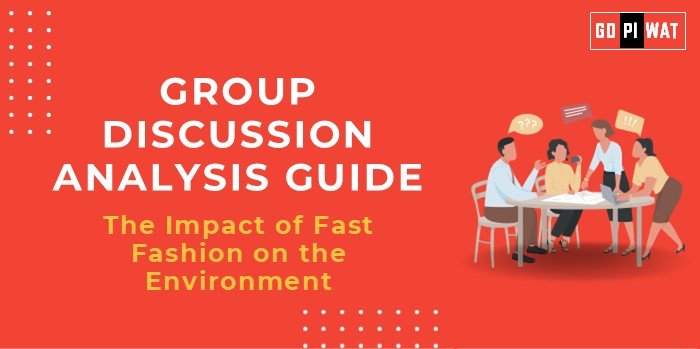📋 Group Discussion Analysis Guide: The Impact of Fast Fashion on the Environment
🌐 Introduction to the Impact of Fast Fashion
Fast fashion, characterized by rapidly produced, low-cost clothing lines designed to emulate current trends, has transformed the global apparel industry. The constant cycle of production and disposal has brought significant environmental concerns to the forefront, making it a relevant topic for B-school students interested in sustainability, business ethics, and corporate responsibility.
📊 Quick Facts and Key Statistics
- ♻️ Textile Waste: 92 million tons of textile waste are generated globally each year, much of it from fast fashion, exacerbating landfill overflow.
- 💧 Water Usage: Producing a single cotton T-shirt requires 2,700 liters of water, highlighting water wastage in fast fashion production.
- 🌍 Carbon Emissions: The fashion industry contributes around 10% of global carbon emissions, surpassing both aviation and shipping industries.
- ⚗️ Chemical Use: Fast fashion production utilizes 1,500+ chemicals, many of which are harmful and non-recyclable, affecting soil and water quality.
🤝 Stakeholders and Their Roles
- 🧵 Fashion Brands: Innovate on eco-friendly production methods, transparent sourcing, and sustainable practices.
- 🏛️ Government & Environmental Agencies: Implement regulations on waste management, emissions, and chemical usage in textiles.
- 🛍️ Consumers: Drive demand for sustainable fashion choices by prioritizing eco-friendly brands and secondhand options.
- 🌱 Environmental NGOs: Advocate for sustainable practices and hold brands accountable through awareness campaigns and certifications.
🏆 Achievements and Challenges
✨ Achievements
- 🌟 Rise of Sustainable Fashion Brands: Brands like Patagonia and H&M Conscious have introduced sustainable product lines, signaling a shift in consumer preference.
- 🌍 Global Initiatives: The UN’s Fashion Industry Charter for Climate Action aims for 30% GHG reduction by 2030 in the industry.
- 📈 Increased Consumer Awareness: A growing consumer base is showing preference for eco-friendly options, supporting brands that prioritize sustainability.
⚠️ Challenges
- ♻️ Waste Management: Textile recycling remains minimal, with less than 1% of clothing recycled into new garments.
- 💧 Water Pollution: The dyeing and treatment processes in fast fashion are among the largest polluters of freshwater globally.
- 🤔 Labor Concerns: Fast fashion is associated with low wages and poor working conditions, complicating ethical sourcing.
🌍 Global Comparisons
- 🇪🇺 Europe: Leading in regulating textile waste with mandatory recycling targets and extended producer responsibility frameworks.
- 🇸🇪 Case Study – Sweden: Introduced a tax on harmful chemicals used in textiles.
- 🇧🇩 Case Study – Bangladesh: Efforts are underway to improve environmental and labor conditions through local NGOs and international collaborations.
📚 Structured Arguments for Discussion
“Fast fashion democratizes fashion by making it affordable and accessible, but it must be balanced with responsible, sustainable practices.”
“The fast fashion model is inherently unsustainable, exploiting resources and people while contributing massively to pollution and waste.”
“While fast fashion has made style accessible, its environmental costs are high. Moving toward sustainable practices is crucial to mitigate this impact.”
🗣️ Effective Discussion Approaches
🚀 Opening Approaches
- 📊 Statistics-Based: “With 92 million tons of textile waste annually, fast fashion’s environmental footprint is substantial and growing.”
- 🔀 Contrasting View: “While fast fashion makes trends accessible, the long-term environmental cost demands a reevaluation.”
🛠️ Counter-Argument Handling
- ♻️ Emphasize alternatives like circular fashion.
- 🌱 Highlight the need for consumer responsibility in sustainable fashion choices.
📈 Strategic Analysis of Strengths and Weaknesses
- 💡 Strengths: Accessibility, economic contribution, trend adaptability.
- ⚠️ Weaknesses: High waste generation, pollution, ethical labor concerns.
- ✨ Opportunities: Rise of eco-conscious consumers, potential for innovation in sustainable textiles.
- ⚡ Threats: Increasing regulatory pressures, potential consumer backlash.
🎓 Connecting with B-School Applications
- 📂 Real-World Applications: Ideal for projects in sustainability, circular economy, supply chain, and consumer behavior.
- 🧐 Sample Interview Questions:
- “How should fast fashion brands balance affordability and sustainability?”
- “What role does consumer behavior play in driving sustainable fashion?”
- 🌟 Insights for B-School Students: Awareness of sustainable sourcing, importance of CSR in the apparel sector, and understanding consumer demand for ethical products.


